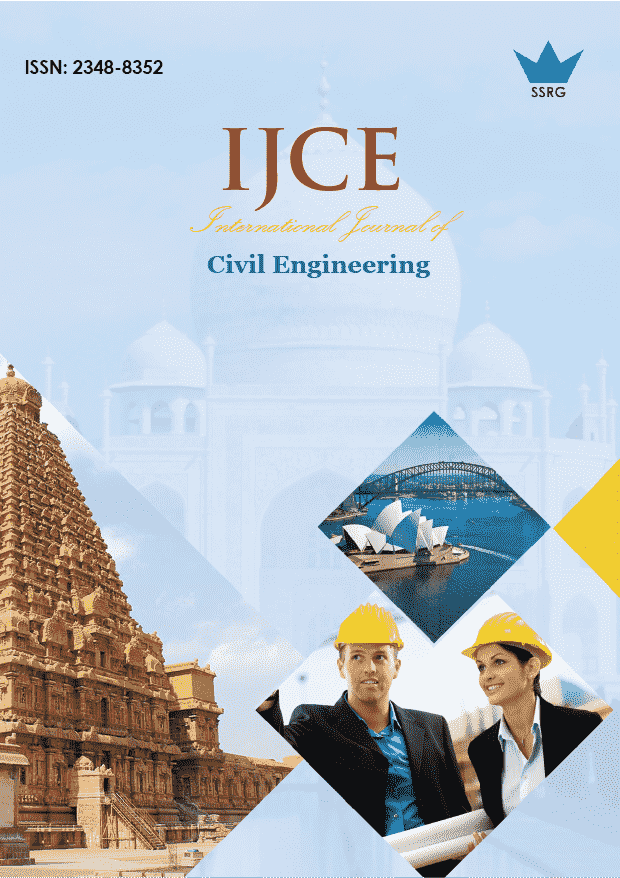Modal Analysis of Earthen Heritage Sites: A Case Study of the Hanguang Gate Section of the Xi’an City Wall

| International Journal of Civil Engineering |
| © 2025 by SSRG - IJCE Journal |
| Volume 12 Issue 3 |
| Year of Publication : 2025 |
| Authors : Ruijuan Yang, Masyitah Md Nujid, Aifang Wu |
How to Cite?
Ruijuan Yang, Masyitah Md Nujid, Aifang Wu, "Modal Analysis of Earthen Heritage Sites: A Case Study of the Hanguang Gate Section of the Xi’an City Wall," SSRG International Journal of Civil Engineering, vol. 12, no. 3, pp. 40-46, 2025. Crossref, https://doi.org/10.14445/23488352/IJCE-V12I3P104
Abstract:
The Xi’an City Wall, a prominent earthen heritage site in China with over 600 years of history, holds significant cultural, economic, and archaeological value. Over centuries, it has undergone progressive deterioration due to natural weathering, seismic events, and environmental vibrations, with vibrations identified as a critical factor in structural degradation. Despite this, the dynamic characteristics of earthen heritage sites under vibration remain poorly understood. This study addresses this gap by employing a three-dimensional finite element model to investigate the modal behavior of the Hanguang Gate section of the Xi’an City Wall, China, providing new insights into the damage mechanisms induced by environmental vibrations. Results reveal that the wall's natural frequencies fall within a low-frequency range, with stress concentration occurring at geometric transitions and peak displacement observed at the upper regions. These findings enhance the understanding of vibrational damage mechanisms and provide a scientific foundation for developing targeted vibration isolation strategies to preserve earthen heritage structures.
Keywords:
City wall, Earthen sites, Environmental vibrations, Modal analyses, Numerical simulations.
References:
[1] Dexuan Zhang et al., “Laboratory Experimental Study of Infrared Imaging Technology Detecting the Conservation Effect of Ancient Earthen Sites (Jiaohe Ruins) in China,” Engineering Geology, vol. 125, pp. 66-73, 2012.
[CrossRef] [Google Scholar] [Publisher Link]
[2] Qiyong Zhang et al., “Salt Distribution of Earthen Heritage Site Wall and its Mechanism in Northern China,” Journal of Building Engineering, vol. 76, 2023.
[CrossRef] [Google Scholar] [Publisher Link]
[3] Yu Wang et al., “Microbial Diversity of Archaeological Ruins of Liangzhu City and its Correlation with Environmental Factors,” International Biodeterioration & Biodegradation, vol. 175, pp. 1-8, 2022.
[CrossRef] [Google Scholar] [Publisher Link]
[4] Rong Yan et al., “Application of Bakelite Rod Anchor in Protection of Tang Hanguangmen Entrance Remains,” Journal of Shaanxi Normal University(Natural Science Edition), vol. 44, no. 3, pp. 69-74, 2016.
[Google Scholar] [Publisher Link]
[5] Meng Ma et al., “Study of the Train-Induced Vibration Impact on a Historic Bell Tower above Two Spatially Overlapping Metro Lines,” Soil Dynamics and Earthquake Engineering, vol. 81, pp. 58-74, 2016.
[CrossRef] [Google Scholar] [Publisher Link]
[6] Bin Zhao, Fabio Taucer, and Tiziana Rossetto, “Field Investigation on the Performance of Building Structures during the 12 May 2008 Wenchuan Earthquake in China,” Engineering Structures, vol. 31, no. 8, pp. 1707-1723, 2009.
[CrossRef] [Google Scholar] [Publisher Link]
[7] N. Claudia, and B. Cancino, “Damage Assessment of Historic Earthen Sites after the 2007 Earthquake in Peru,” Advanced Materials Research, vol. 133-134, pp. 665-670, 2010.
[CrossRef] [Google Scholar] [Publisher Link]
[8] Dina D'Ayala, and Gianmario Benzoni, “Historic and Traditional Structures during the 2010 Chile Earthquake: Observations, Codes, and Conservation Strategies,” Earthquake Spectra, vol. 28, no. 1, pp. 425-451, 2012.
[CrossRef] [Google Scholar] [Publisher Link]
[9] Jimin He, and Zhi-Fang Fu, Overview of Modal Analysis, Modal Analysis, Butterworth-Heinemann Oxford, UK, pp. 1-11, 2001.
[Google Scholar]
[10] D.J. Ewins, Modal Testing: Theory, Practice and Application, John Wiley & Sons, pp. 1-592, 2009.
[Google Scholar] [Publisher Link]
[11] Zhi-Fang Fu, and Jimin He, Modal Analysis, Elsevier, pp. 1-304, 2001.
[Google Scholar] [Publisher Link]
[12] Álvaro Cunha, and Elsa Caetano, “Experimental Modal Analysis of Civil Engineering Structures,” Sound and Vibration, pp. 12-20, 2006.
[Google Scholar] [Publisher Link]
[13] M.L. Wang, G. Heo, and D. Satpathi, “Dynamic Characterization of a Long Span Bridge: A Finite Element Based Approach,” Soil Dynamics and Earthquake Engineering, vol. 16, no. 7-8, pp. 503-512, 1997.
[CrossRef] [Google Scholar] [Publisher Link]
[14] Paolo Zimmaro, and Ernesto Ausilio, “Numerical Evaluation of Natural Periods and Mode Shapes of Earth Dams for Probabilistic Seismic Hazard Analysis Applications,” Geosciences, vol. 10, no. 12, pp. 1-11, 2020.
[CrossRef] [Google Scholar] [Publisher Link]
[15] Javier A. Ramírez et al., “Daily and Seasonal Effects of Environmental Temperature and Humidity on the Modal Properties of Structures,” Bulletin of Earthquake Engineering, vol. 20, pp. 4533-4559, 2022.
[CrossRef] [Google Scholar] [Publisher Link]
[16] Mahadevan Ilankatharan, and Bruce Kutter, “Modeling Input Motion Boundary Conditions for Simulations of Geotechnical Shaking Table Tests,” Earthquake Spectra, vol. 26, no. 2, pp. 349-369, 2010.
[CrossRef] [Google Scholar] [Publisher Link]
[17] Zhicheng Liu et al., “Research on Modal Recognition Technology and Vibration Response Analysis of Transmission Tower,” Measurement, vol. 245, 2025.
[CrossRef] [Google Scholar] [Publisher Link]
[18] Yingrui Wu et al., “Automatic Operational Modal Analysis for Concrete Arch Dams Integrating Improved Stabilization Diagram with Hybrid Clustering Algorithm,” Mechanical Systems and Signal Processing, vol. 224, 2025.
[CrossRef] [Google Scholar] [Publisher Link]
[19] Jingui Zhao et al., “N-Sided Polygonal Cell-Based Smoothed Finite Element Method (nCS-FEM) Based on Wachspress Shape Function for Modal Analysis,” Engineering Analysis with Boundary Elements, vol. 159, pp. 434-451, 2024.
[CrossRef] [Google Scholar] [Publisher Link]
[20] Federica Greco, and Paulo B. Lourenço, “Seismic Assessment of Large Historic Vernacular Adobe Buildings in the Andean Region of Peru. Learning from Casa Arones in Cusco,” Journal of Building Engineering, vol. 40, 2021.
[CrossRef] [Google Scholar] [Publisher Link]
[21] Georgios Karanikoloudis, and Paulo B. Lourenço, “Structural Assessment and Seismic Vulnerability of Earthen Historic Structures Application of Sophisticated Numerical and Simple Analytical Models,” Engineering Structures, vol. 160, pp. 488-509, 2018.
[CrossRef] [Google Scholar] [Publisher Link]
[22] Fernando Ávila et al., “Influence of Crack Propagation on the Seismic Behavior of Historic Rammed Earth Buildings: The Tower of Muhammad in the Alhambra (Spain),” Engineering Structures, vol. 301, 2024.
[CrossRef] [Google Scholar] [Publisher Link]

 10.14445/23488352/IJCE-V12I3P104
10.14445/23488352/IJCE-V12I3P104